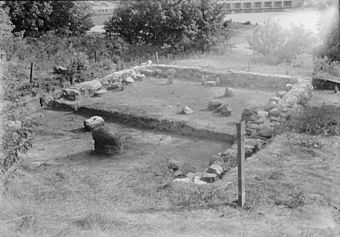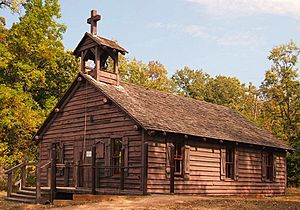Lac qui Parle Mission facts for kids
Quick facts for kids |
|
|
Lac qui Parle Mission Archeological Historic District
|
|

Lac Qui Parle Mission Church (Ruins)
|
|
| Location | Lac qui Parle County / Chippewa County |
|---|---|
| Nearest city | Watson, Minnesota |
| NRHP reference No. | 73000971 |
| Added to NRHP | March 14, 1973 |
The Lac qui Parle Mission is a very old and important historical site in Chippewa County, Minnesota. It was started in June 1835 by Dr. Thomas Smith Williamson and Alexander Huggins. They were invited by a fur trader named Joseph Renville to come to the area.
The name "Lac qui Parle" comes from the French words for "lake which speaks." This was a translation of the native Dakota name, "Mde Iyedan." This mission was a place where Christian missionaries worked with the Dakota people for almost 20 years. It was also where the first dictionary of the Dakota language was created, and parts of the Bible were translated into Dakota for the very first time.
Joseph Renville had many friends and family in the Native community, which helped the mission. After he passed away in 1846, a person named Martin McLeod took over. The relationship between the mission and the Dakota people became difficult. Because of this, the missionaries left the site in 1854. They moved to the Upper Sioux Agency.
The mission building was rebuilt in 1942 by the Works Progress Administration. This was a government program that helped people find jobs during a tough time. Today, the mission is looked after by the Chippewa County Historical Society. They work together with the Minnesota Historical Society to preserve this important place.
Contents
Fort Renville: A Historic Trading Post
The Lac qui Parle Mission site is also home to the remains of Fort Renville. This was a fortified home and trading post. It was built in 1826 by the explorer and fur trader Joseph Renville.
What Was Fort Renville Like?
The fort had two houses and a storage building. It was surrounded by a strong fence called a stockade. It also had a bastion and a watchtower for protection. The fort was about half a mile from the mission.
Importance of Fort Renville
Fort Renville was a very important outpost in southwestern Minnesota. It was a common stopping point for traders. These traders traveled along the Red River Trails. After Joseph Renville passed away in 1846, the fort was no longer used.
Preserving the Site
The site of Fort Renville was explored by archaeologists in 1940. Today, the Minnesota Historical Society protects it. The public cannot visit the fort's remains, but its history is preserved.


